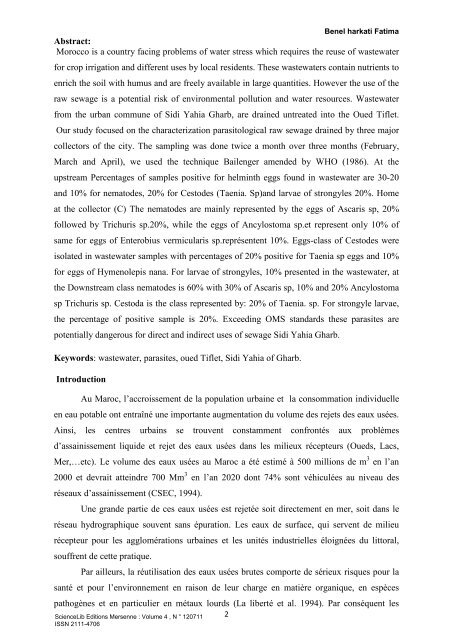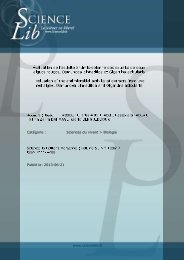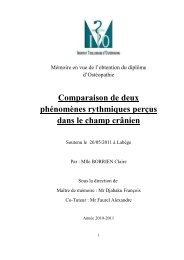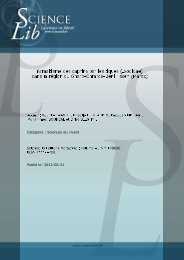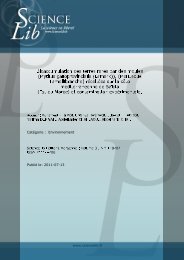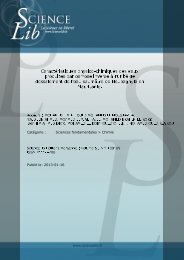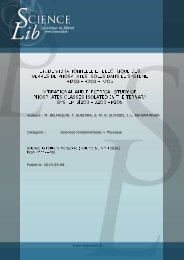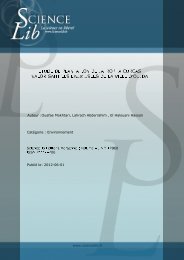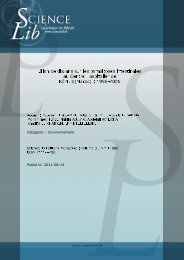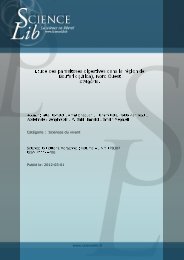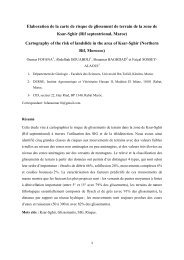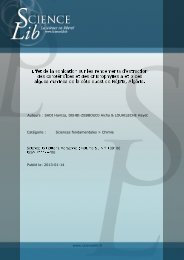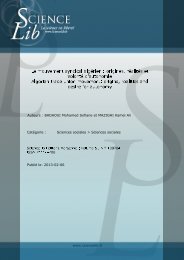Analyse parasitologique des eaux usées brutes de la ... - Sciencelib
Analyse parasitologique des eaux usées brutes de la ... - Sciencelib
Analyse parasitologique des eaux usées brutes de la ... - Sciencelib
Create successful ePaper yourself
Turn your PDF publications into a flip-book with our unique Google optimized e-Paper software.
Benel harkati Fatima<br />
Abstract:<br />
Morocco is a country facing problems of water stress which requires the reuse of wastewater<br />
for crop irrigation and different uses by local resi<strong>de</strong>nts. These wastewaters contain nutrients to<br />
enrich the soil with humus and are freely avai<strong>la</strong>ble in <strong>la</strong>rge quantities. However the use of the<br />
raw sewage is a potential risk of environmental pollution and water resources. Wastewater<br />
from the urban commune of Sidi Yahia Gharb, are drained untreated into the Oued Tiflet.<br />
Our study focused on the characterization parasitological raw sewage drained by three major<br />
collectors of the city. The sampling was done twice a month over three months (February,<br />
March and April), we used the technique Bailenger amen<strong>de</strong>d by WHO (1986). At the<br />
upstream Percentages of samples positive for helminth eggs found in wastewater are 30-20<br />
and 10% for nemato<strong><strong>de</strong>s</strong>, 20% for Cesto<strong><strong>de</strong>s</strong> (Taenia. Sp)and <strong>la</strong>rvae of strongyles 20%. Home<br />
at the collector (C) The nemato<strong><strong>de</strong>s</strong> are mainly represented by the eggs of Ascaris sp, 20%<br />
followed by Trichuris sp.20%, while the eggs of Ancylostoma sp.et represent only 10% of<br />
same for eggs of Enterobius vermicu<strong>la</strong>ris sp.représentent 10%. Eggs-c<strong>la</strong>ss of Cesto<strong><strong>de</strong>s</strong> were<br />
iso<strong>la</strong>ted in wastewater samples with percentages of 20% positive for Taenia sp eggs and 10%<br />
for eggs of Hymenolepis nana. For <strong>la</strong>rvae of strongyles, 10% presented in the wastewater, at<br />
the Downstream c<strong>la</strong>ss nemato<strong><strong>de</strong>s</strong> is 60% with 30% of Ascaris sp, 10% and 20% Ancylostoma<br />
sp Trichuris sp. Cestoda is the c<strong>la</strong>ss represented by: 20% of Taenia. sp. For strongyle <strong>la</strong>rvae,<br />
the percentage of positive sample is 20%. Exceeding OMS standards these parasites are<br />
potentially dangerous for direct and indirect uses of sewage Sidi Yahia Gharb.<br />
Keywords: wastewater, parasites, oued Tiflet, Sidi Yahia of Gharb.<br />
Introduction<br />
Au Maroc, l’accroissement <strong>de</strong> <strong>la</strong> popu<strong>la</strong>tion urbaine et <strong>la</strong> consommation individuelle<br />
en eau potable ont entraîné une importante augmentation du volume <strong><strong>de</strong>s</strong> rejets <strong><strong>de</strong>s</strong> <strong>eaux</strong> <strong>usées</strong>.<br />
Ainsi, les centres urbains se trouvent constamment confrontés aux problèmes<br />
d’assainissement liqui<strong>de</strong> et rejet <strong><strong>de</strong>s</strong> <strong>eaux</strong> <strong>usées</strong> dans les milieux récepteurs (Oueds, Lacs,<br />
Mer,…etc). Le volume <strong><strong>de</strong>s</strong> <strong>eaux</strong> <strong>usées</strong> au Maroc a été estimé à 500 millions <strong>de</strong> m 3 en l’an<br />
2000 et <strong>de</strong>vrait atteindre 700 Mm 3 en l’an 2020 dont 74% sont véhiculées au niveau <strong><strong>de</strong>s</strong><br />
rés<strong>eaux</strong> d’assainissement (CSEC, 1994).<br />
Une gran<strong>de</strong> partie <strong>de</strong> ces <strong>eaux</strong> <strong>usées</strong> est rejetée soit directement en mer, soit dans le<br />
réseau hydrographique souvent sans épuration. Les <strong>eaux</strong> <strong>de</strong> surface, qui servent <strong>de</strong> milieu<br />
récepteur pour les agglomérations urbaines et les unités industrielles éloignées du littoral,<br />
souffrent <strong>de</strong> cette pratique.<br />
Par ailleurs, <strong>la</strong> réutilisation <strong><strong>de</strong>s</strong> <strong>eaux</strong> <strong>usées</strong> <strong>brutes</strong> comporte <strong>de</strong> sérieux risques pour <strong>la</strong><br />
santé et pour l’environnement en raison <strong>de</strong> leur charge en matière organique, en espèces<br />
pathogènes et en particulier en métaux lourds (La liberté et al. 1994). Par conséquent les<br />
2<br />
ScienceLib Editions Mersenne : Volume 4 , N ° 120711<br />
ISSN 2111-4706


